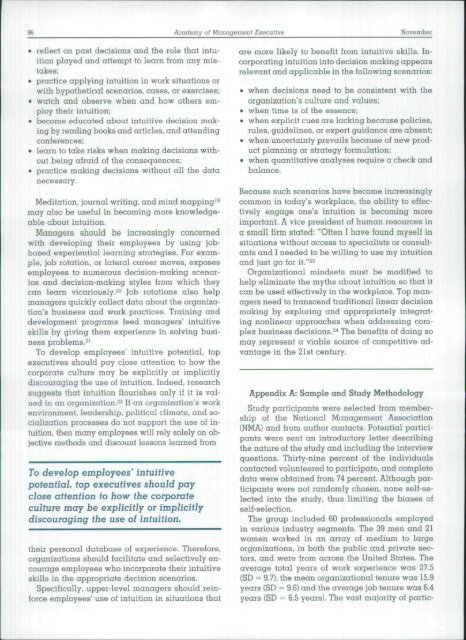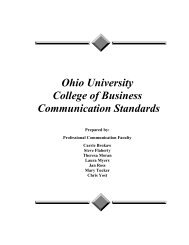Taking the mystery out of intuitive decision making
Taking the mystery out of intuitive decision making
Taking the mystery out of intuitive decision making
You also want an ePaper? Increase the reach of your titles
YUMPU automatically turns print PDFs into web optimized ePapers that Google loves.
96 Academy <strong>of</strong> Management Executive November<br />
• reflect on past <strong>decision</strong>s and <strong>the</strong> role that intuition<br />
played and attempt to learn from any mistakes;<br />
• practice applying intuition in work situations or<br />
with hypo<strong>the</strong>tical scenarios, cases, or exercises;<br />
• watch and observe when and how o<strong>the</strong>rs employ<br />
<strong>the</strong>ir intuition;<br />
• become educated ab<strong>out</strong> <strong>intuitive</strong> <strong>decision</strong> <strong>making</strong><br />
by reading books and articles, and attending<br />
conferences;<br />
• learn to take risks when <strong>making</strong> <strong>decision</strong>s with<strong>out</strong><br />
being afraid <strong>of</strong> <strong>the</strong> consequences;<br />
• practice <strong>making</strong> <strong>decision</strong>s with<strong>out</strong> all <strong>the</strong> data<br />
necessary.<br />
Meditation, journal writing, and mind<br />
may also be useful in becoming more knowledgeable<br />
ab<strong>out</strong> intuition.<br />
Managers should be increasingly concerned<br />
with developing <strong>the</strong>ir employees by using jobbased<br />
experiential learning strategies. For example,<br />
job rotation, or lateral career moves, exposes<br />
employees to numerous <strong>decision</strong>-<strong>making</strong> scenarios<br />
and <strong>decision</strong>-<strong>making</strong> styles from which <strong>the</strong>y<br />
can learn vicariously.^o Job rotations also help<br />
managers quickly collect data ab<strong>out</strong> <strong>the</strong> organization's<br />
business and work practices. Training and<br />
development programs feed managers' <strong>intuitive</strong><br />
skills by giving <strong>the</strong>m experience in solving business<br />
problems.^'<br />
To develop employees' <strong>intuitive</strong> potential, top<br />
executives should pay close attention to how <strong>the</strong><br />
corporate culture may be explicitly or implicitly<br />
discouraging <strong>the</strong> use <strong>of</strong> intuition. Indeed, research<br />
suggests that intuition flourishes only if it is valued<br />
in an organization.22 If an organization's work<br />
environment, leadership, political climate, and socialization<br />
processes do not support <strong>the</strong> use <strong>of</strong> intuition,<br />
<strong>the</strong>n many employees will rely solely on objective<br />
methods and discount lessons learned from<br />
To develop employees' <strong>intuitive</strong><br />
potential top executives should pay<br />
close attention to how <strong>the</strong> corporate<br />
culture may be explicitly or implicitly<br />
discouraging <strong>the</strong> use 0/ intuition.<br />
<strong>the</strong>ir personal database <strong>of</strong> experience. Therefore,<br />
organizations should facilitate and selectively encourage<br />
employees who incorporate <strong>the</strong>ir <strong>intuitive</strong><br />
skills in <strong>the</strong> appropriate <strong>decision</strong> scenarios.<br />
Specifically, upper-level managers should reinforce<br />
employees' use <strong>of</strong> intuition in situations that<br />
are more likely to benefit from <strong>intuitive</strong> skills. Incorporating<br />
intuition into <strong>decision</strong> <strong>making</strong> appears<br />
relevant and applicable in <strong>the</strong> following scenarios:<br />
• when <strong>decision</strong>s need to be consistent with <strong>the</strong><br />
organization's culture and values;<br />
• when time is <strong>of</strong> <strong>the</strong> essence;<br />
• when explicit cues are lacking because policies,<br />
rules, guidelines, or expert guidance are absent;<br />
• when uncertainty prevails because <strong>of</strong> new product<br />
planning or strategy formulation;<br />
• when quantitative analyses require a check and<br />
balance.<br />
Because such scenarios have become increasingly<br />
common in today's workplace, <strong>the</strong> ability to effectively<br />
engage one's intuition is becoming more<br />
important. A vice president <strong>of</strong> human resources in<br />
a small firm stated: "Often I have found myself in<br />
situations with<strong>out</strong> access to specialists or consultants<br />
and I needed to be willing to use my intuition<br />
and just go for it."^^<br />
Organizational mindsets must be modified to<br />
help eliminate <strong>the</strong> myths ab<strong>out</strong> intuition so that it<br />
can be used effectively in <strong>the</strong> workplace. Top managers<br />
need to transcend traditional linear <strong>decision</strong><br />
<strong>making</strong> by exploring and appropriately integrating<br />
nonlinear approaches when addressing complex<br />
business <strong>decision</strong>s.^^ The benefits <strong>of</strong> doing so<br />
may represent a viable source <strong>of</strong> competitive advantage<br />
in <strong>the</strong> 21st century.<br />
Appendix A: Sample and Study Methodology<br />
Study participants were selected from membership<br />
<strong>of</strong> <strong>the</strong> National Management Association<br />
(NMA) and from author contacts. Potential participants<br />
were sent an introductory letter describing<br />
<strong>the</strong> nature <strong>of</strong> <strong>the</strong> study and including <strong>the</strong> interview<br />
questions. Thirty-nine percent <strong>of</strong> <strong>the</strong> individuals<br />
contacted volunteered to participate, and complete<br />
data were obtained from 74 percent. Although participants<br />
were not randomly chosen, none self-selected<br />
into <strong>the</strong> study, thus limiting <strong>the</strong> biases <strong>of</strong><br />
self-selection.<br />
The group included 60 pr<strong>of</strong>essionals employed<br />
in various industry segments. The 39 men and 21<br />
women worked in an array <strong>of</strong> medium to large<br />
organizations, in both <strong>the</strong> public and private sectors,<br />
and were from across <strong>the</strong> United States. The<br />
average total years <strong>of</strong> work experience was 27.5<br />
(SD = 9.7), <strong>the</strong> mean organizational tenure was 15.9<br />
years {SD = 9.6} and <strong>the</strong> average job tenure was 6.4<br />
years (SD = 6.5 years). The vast majority <strong>of</strong> partic-




